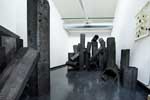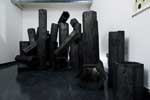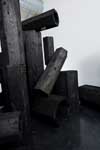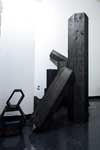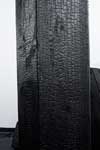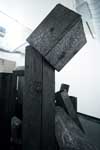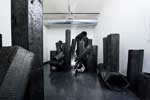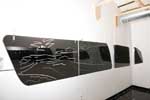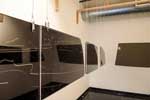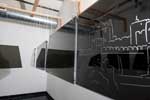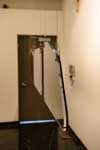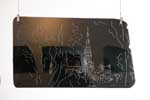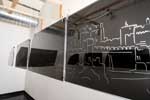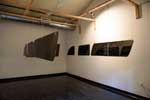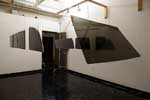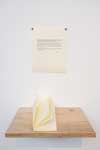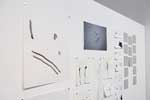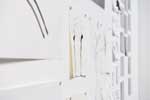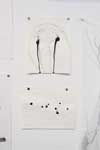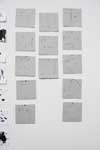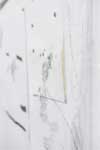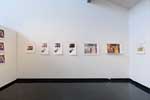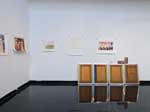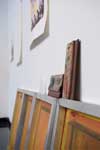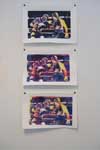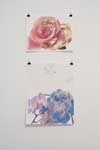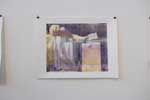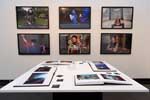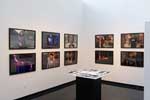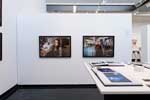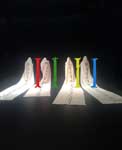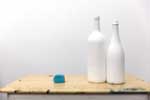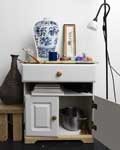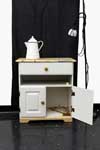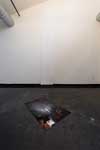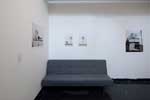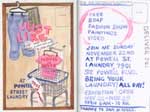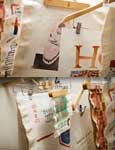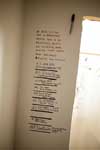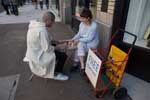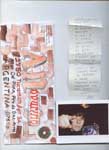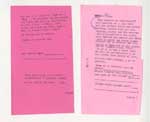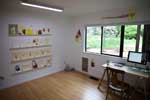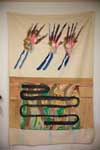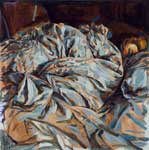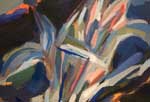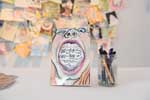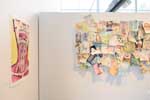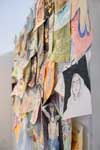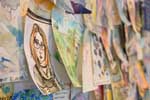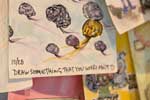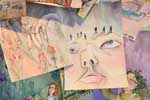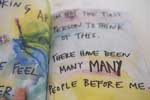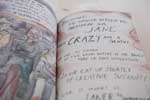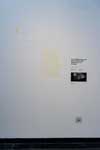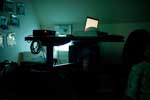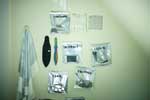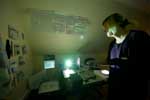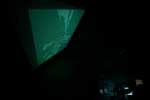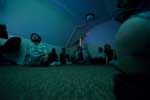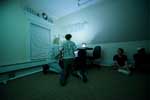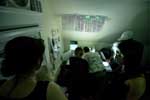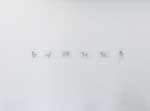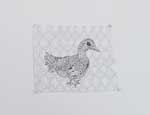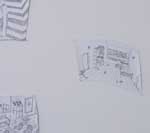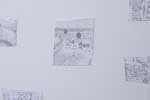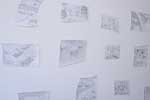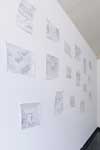2016 Senior Theses
Abigail Emiko Inoue Cox
Forecasting Cascadia: metabolic architecture and climate change
This thesis presents a hypothetical utopian architectural solution to the myriad problems posed by climate change. Composed of 3D sculptural and 2D printed components, Forecasting Cascadia explores the possibility of a successful utopia in this ephemeral autonomous bioregion. What does a utopia, staring down the barrel of climate disaster, look like?
The first chapter describes two artworks, Yakisugi-ban (meaning burnt-cedar-plank in Japanese), and Carbon Footprint; their methods of creation, and their presence in the exhibition.
The second chapter focuses on the work of two optimistic architects, Yona Friedman and Lebbeus Woods, and and distills their practice, philosophy, and legacies. Additionally the practice of Architecture for Humanity is aligned with the utopian and cooperative approach of Friedman and Woods.
The third chapter addresses utopias, in history, development, widespread implementation and representation.
Finally, the fourth chapter is devoted to the Japanese Metabolism avant-garde movement. Their understanding of the nature of building is laden with potential for utopian dreams and dreamers of the twenty-first century.
Camila Medina Mora
Both/neither
This thesis explores the reproduction of space through memory in exile in the context of twentieth-century Latin American literature, Mexican film, and nineteenth-century British romantic landscape painting. Texts by Henri Lefebvre and Gaston Bachelard act as the theoretical backbone as I explore the production of space and its association with memory, while Edward Said's essays on exile are used as a starting point for a larger conversation about the collective global identity of exile. Additionally, I look at my experiences growing up in Mexico City prior to moving to the United Kingdom, my family's history, and my relationship to the spaces I am trying to recreate. In particular, I look at my life through the time I spent being driven around in an armoured suburban. The result is an art installation of a sort of ghost of the car. Only the windows are left, concealing drawings of pastoral Britain inspired by Turner and Constable within two thick panels of acrylic. Sound surrounds the structure, providing the viewer with an immersive experience that reflects my own personal history.
Cylvia Jean Michelle Davis
Poetry and form in visual practice
My choice of major was motivated by language. Poetry has been a guiding force for my artistic development, but I began to wonder if it was doing more than just guiding. What did it hide, or open for my concepts and ideas? Thusly, my engagement of form and materiality in visual art attempted to plot out a building dissatisfaction with language. The poems, to my delight and confusion, resisted reformation at first, emulating a stubborn streak in their maker. However, as the project developed, leaving the poems out of a concrete, visual or language poem mode and in their raw form led to visual components that were doing more or as much work, though in a different way, a the texts. This work also seemed "truer." The thesis seems to be medium specific — most of the studies I made were in print, collage, book and sculptural disciplines of my visual arts practice. What is then, my ideal practice as a multi-disciplinary artist? I don't have an answer yet.
Ella Smith
Facture/faktura: exploding artwork and alchemy of labor
Exposing, foregrounding, and semanticizing the "mistake," the "technical accident," and the "fabrication" of a work of art appears to be a radical marker of modernity in the history of art. My thesis addresses this phenomenon through two parallel tracks: by studying representative episodes in 20th century artistic practice; and by producing a portfolio of CMMYK-process screen prints of art works from these representative episodes. I examine Sergei Mikhailovich Prokudin-Gorskii's color photographs produced at the turn of the century in Imperial Russia; the Constructivist drawings of Karl Ioganson from the early years of the Bolshevik Revolution; and Andy Warhol's Pop "deconstructions" of Leonardo Da Vinci's "Mona Lisa" in 1963. Each of these unpacks the relationship between the making of an artwork and the artwork itself from different perspectives and with different objectives, informed - in the case of the latter two - by ideological claims. My analysis investigates the relationship of technique, technology, material, aesthetic theory, and social critique in each case study through the concept of faktura/facture. The studio component of my thesis subjects the target works to the manipulation of CMYK-process screen-printing to demonstrate the visual and ideological changes a work undergoes when subject to such medium interference. So strong is the medium-specific mark left by this type of screen-printing, and so entrenched is my medium in the history of mechanical reproduction of artworks, that the effects of my intervention challenge the boundary between the original and the reproduction. The works in my portfolio exist as visual oxymora, simultaneously presenting itself as a reproduction and an original.
Gitanjali Castallian
Live loud: the heavy metal underground in Portland
My thesis "Live Loud" consists of a 70-page book of photographic portraits documenting individuals in the heavy metal underground community in Portland, Oregon. 12 photos from the book have been printed large-scale for closer examination. The written component of my thesis traces the evolution of heavy metal as identity throughout the past 5 decades and delves into identity construction, identity performance and gender performance within the heavy metal identity.
Grace Poetzinger
A performance of ritual invention
Through a choreographic investigation based on research into medieval ritual and Samuel Beckett's Quad, this thesis discusses the performance of ritual, the ritual-likeness of performance, and the potential for ritual invention. The first chapter looks at how ritual is represented, referenced and created in a play for television by Samuel Beckett. I use this play to deconstruct the use of repetition in both Western secular performance tradition and the European tradition of religious ritual. A second chapter discusses the relationship between text and performance in medieval ritual, and looks at the performative role of texts in an effort to see how hearing and speaking constitute a performance of ritual efficacy in medieval ritual. The third chapter describes my motivations and experiences in making a performance with ritual-like elements. I talk about my desire to create ritual efficacy in a concert performance, how this desire translated into choreographic decisions, and how the performance of IIII dialogued with themes of ritual efficacy that I pull from the previous two chapters.
Harrison R. Martin
A provisional photography
I hope that these three chapters will help illuminate my thinking over the past two semester, and that they will provide a bit of context for my photographs. Think of them as a progression of thought. They do not necessarily speak to one another, rather, they provide three moments of exposition.
In Chapter 1 I write about provisional painting and its connection of photography. This type of painting provided the ideological beginnings for my work. I felt that both painting and photography were experiencing similar existential crises. The way in which provisional painters responded to that crises was one I wanted to apply to my work.
Chapter 2 is an investigation into indexicality, magic, and photography. In the introduction to his book Windows, Mirrors, Tabletops, Lucas Blalock mentions the article "The Real Work: Modern magic and the meaning of life" by Adam Gopnik. This relating of magic to photography stayed at the forefront of my mind for most of the second semester. I later came to see a connection between magic and photographic indexicality. I try in this chapter to show the different ways in which a photograph can be magical, the different ways that it can be indexical.
A brief essay about my work and the path that it took over the course of the year makes up the third chapter. I did not try to explain my art in detail. I tried simply to show the larger progression of my creative interests and aspirations. The process of taking photographs and discussing them with my advisor was not neatly planned out. I would make images every week and bring them to him. We would talk about what worked and what didn't, where we thought the work was heading, artists whom I had been looking for inspiration, and so on. I felt as if I were chasing a string through a dark mine. The work evolved organically.
Jade Mara Novarino
Making space: just like; free manicures; hola pa yellow gel pen; Jonathan Hartshorn at Conduit
This thesis deals with topics related to social practice, interventionism, relationality, and art outside of institutions. In the time between September 2015-April 2016 I enacted different projects to experiment within the above genres and modes of working. My thesis took place in many locations throughout Portland and some of it now resides in Mar Del Plata, Argentina. My projects consisted of: an art exhibition that I organized at a laundromat in SE Portland; a giveaway of paintings at an exhibition as well as a mobile art piece consisting of free manicures; a mail correspondence project between my father and I; and an exhibition of works by artist Jonathan Hartshorn curated by Eli Coplan and myself (Conduit). Duration, location, medium, form of distribution, and artist's presence are aspects that are consistent throughout each project. These four projects respond to problems related to monetary and social capital in the art world in search for better alternatives.
Included in this thesis are figures that accompany the text and each project. However, as a supplement, this thesis includes a thumb drive and a DVD. The thumb drive provides additional photographs from each project. The DVD is a video documentation of a lecture that I performed at Reed College on May 4, 2016.
Liana Clark
Love: the passing of time
Margaret MacLean
Calm the fuck down and cheer the fuck up: art therapy for anxiety and depression
This thesis is an exploration of the methods and mechanisms behind art therapy, specifically as treatment for two of the most common mental illnesses: anxiety and depression.
My personal experience with the field of art therapy is just beginning, but my curiosity stems from a life long relationship with art, a diagnosis of mental illness four years ago, and the realization that I use my artistic practice as a form of therapy and I've been doing "art therapy" perhaps all along.
My original plan was to research the best methods for changing the negative thought patterns that contribute to mental illness and translate these therapeutic techniques into a workbook for others. However, I had forgotten that I was inspired by art therapy because I needed a way to help myself.
As my studio practice evolved over the year, I explored a very basic question: why do I feel better when I make art? I found many parallels between my painting practice and talk-therapy, specifically Cognitive Behavioral Therapy (CBT), on of the most common forms of treatment for anxiety and depression.
The goal of my artwork is to reduce the stigma of mental illness and inspire others to explore creativity as a form of therapy. In nearly a year of research and six-months spent developing a studio practice, I have grown as an artist and helped to heal myself mentally and physically. Coincidentally or not, I am feeling more healthy and stable than I have in a long time, and I believe that I owe some of my progress to my painting.
Nicholas Zhu
A failed performance and demonstration of the interpersonal and sensory
This document is part of a performance and video installation that takes place between the 2nd and 14th of May in the year 2016. It is intended to be an informative supplement to the work as a whole.
The work is located in an attic room in the Prexy building of Reed College. It is a studio workspace, complete with computer, projectors, speakers, amplifier, drugs, and various works (painting, sculpture, collection, video, sound, etc.) produced during its occupation. All work done in the studio was recorded by a Brinno time-lapse camera, capturing one frame every minute.
This document contains a script of the performance, which begins at the entrance of Prexy and proceeds, in a guided tour fashion, to the installation. Upon arrival the projections take over and the performance is subsumed into a viewing of a recorded (and written below) theoretical section of this document. Following that the projectors turn on white light and the piece may be viewed and questions may be asked of it. The piece continues with a video viewing, and slowly dissipates to an end as the video stops and a Q&A session with the artist follows. During this conference, viewers are advised that they may leave or stay. The duration of the piece up to the conference section is about fifteen minutes.
This document is handed out to each viewer upon beginning the conference section. It has been formatted (included the writing of this abstract) to follow the Reed College thesis guidelines.
Paloma Borromeo Martinez-Miranda
Of spaces: colonial traumas and constructing identity in post-colonial Philippines
